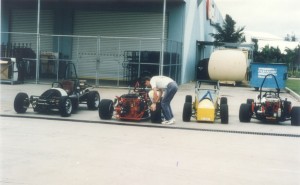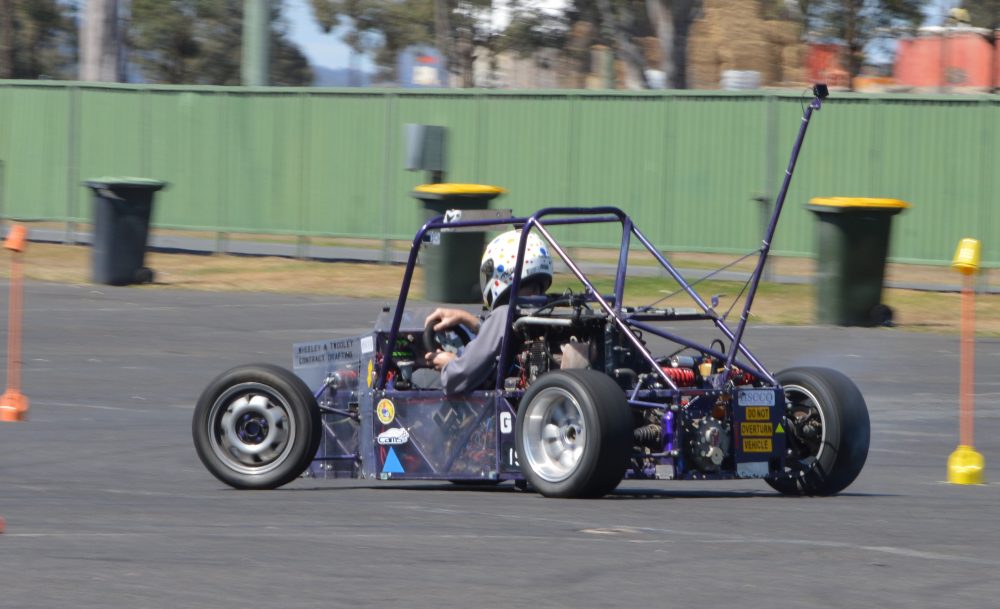GONZALES.
Brisbane, Queensland, Australia.
Gonzales was the sixth motorkhana special built by Alan Wheeley. It was originally planned and sketched in March 1988 when a Kawasaki Z1000 motor was bought from a 1982 model Z1000J bike. The original design was for the car to be front wheel drive, ARTICULATED, with a Toyota Toyoglide auto sun gears to provide the forward/reverse. The name chosen was “Artie Q”. After months on the design, it was realised that because the previous vehicle had been banned, building another car that had very unusual desigh features was an invitation to the knockers to ban this car also. A proof of this concern was demonstrated when a spoof design of a diamond shaped car with a very wide single drive wheel in the centre, steering wheels in the centreline at front and rear, and outrigger casters put outbound from the middle of the car was published in a car club magazine. The spoof design was mentioned at the national level of administration with plans already in place to outlaw it. So the design was toned down greatly, with the bike engine mounted east/west behind the driver, with chain drive from the bike gearbox into the toyoglide gearset inside a home made gearbox behind the solid rear axle, and then driving forward by chain to the rear axle. A number of tentative names were mentioned, but finally decided on Gonzales (the fastest mouse in all of Mehico). Kart handling principals were designed with the solid rear axle by using shaft to hub connectors locking the wheels onto the axle, and rear track was then variable by sliding the hubs along the axle.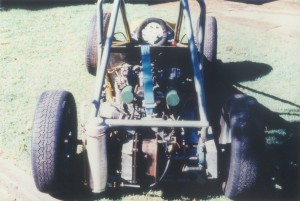
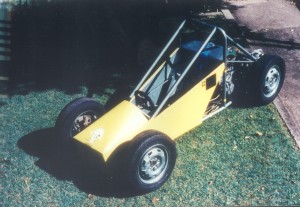 Construction started in November 1993, and the car had its debut at the old Brisbane Airport on 20th February, 1994. One of the shaft to hub connectors could not stand the pressure, with the result of one rear wheel coming off to make the vehicle a trike. The connectors were then discarded, and solid hubs made to key onto the axle. Continual trouble was had with welds in the drivetrain not being strong enough, and all drive to the axle lost. The output shaft of the Toyoglide was made of super hard chromed steel, and a keyway could not be cut in it. So a shrink fit was tried, but this did not work either. At the christmas rebuild, the gearbox was taken apart to check the internals, which turned out to be OK. When installing all the parts and the gears, something got out of alignment, and as soon as drive was transmitted through the box in the first event, the whole internals sheared apart. So a new design was started on a gearbox using Chryslet Torqueflite gears in a home made gearbox that had all the bearings in the wall of the box, and a simple lid. This design allowed everything to be set up, tested by hand, and then simply filled with oil, and sealed. This worked well except for the continuing problem of welding the output sprocket.
Construction started in November 1993, and the car had its debut at the old Brisbane Airport on 20th February, 1994. One of the shaft to hub connectors could not stand the pressure, with the result of one rear wheel coming off to make the vehicle a trike. The connectors were then discarded, and solid hubs made to key onto the axle. Continual trouble was had with welds in the drivetrain not being strong enough, and all drive to the axle lost. The output shaft of the Toyoglide was made of super hard chromed steel, and a keyway could not be cut in it. So a shrink fit was tried, but this did not work either. At the christmas rebuild, the gearbox was taken apart to check the internals, which turned out to be OK. When installing all the parts and the gears, something got out of alignment, and as soon as drive was transmitted through the box in the first event, the whole internals sheared apart. So a new design was started on a gearbox using Chryslet Torqueflite gears in a home made gearbox that had all the bearings in the wall of the box, and a simple lid. This design allowed everything to be set up, tested by hand, and then simply filled with oil, and sealed. This worked well except for the continuing problem of welding the output sprocket.
A full cage was grafted onto the car in May 1997 to make it safer, and a Holden HT gearbox installed in the rear to replace the auto transmission setup. This still had the welding problem until some special chromealloy rods were tried. The front suspension was changed to pushrod operation in April 1998, but the handling was still diabolical without rear suspension. The inside rear wheel would sometimes be 250 millimetres off the ground befor the rear end would slide.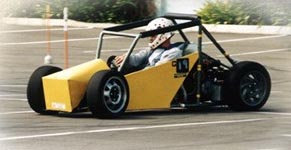
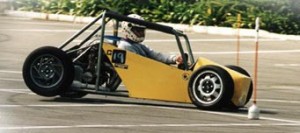
The car was weighed in September 1998, and it came out at 308 kilograms, with approx 26 % on the front wheels.
The front dampers were replaced by ones from the rear of a Suzuki GS 1000 that featured air pressure over the oil reservoir to soften or harden them. The front was gradually hardened, but the problem was only partly solved. A full rebuild was done in January 1999, and this time the second and third gears were left out of the HT gearbox to save a little weight. At the May 1999 event at Coomera, the 2/3 gear selector jammed in the other gears, and punched a hole in the casing. All the oil was drained out, and the box survived the last 3 tests with no oil in it. An Aquabond plug patched the hole, and worked perfectly. Below is a photo of the car when it was fun to drive; tail out slightly, power sliding away from a pole.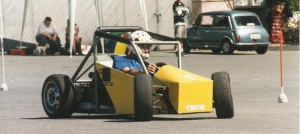
In July 1999 the cage was extended 150 millimetres upward to satisfy new roll bar regulations. It was towed to Nirimba in Sydney for the Australian Motorkhana Championships of 1999 which were called off after a cloudburst flooded the grounds.
New links on the front suspension and dampers pumped up to 45 psi helped the handling enough for it to win its first ever Queensland Championship round in October 1999 at Coomera. The motor was starting to get very tired early in 2000, so the car was taken to a bike expert to get the motor tuned. However at the Australian Motorkhana Championship on 13th August the motor was running very poorly, and needed half choke just to keep it running. New plugs were tried, but made little difference. Then in the Paddy test, the motor started to come good, and in the high speed reverse to the finish garage the motor came on song, but the reverse flick into the garage went wrong with the front tyres suddenly gripping when sideways, and the car rolled over into the garage. During the rollover, Alan’s hands got outside the cage, and hit the bitumen, tearing all the skin and flesh off the backs of them. The car was pushed out of the way, and dumped on its trailer while the driver went to hospital to get his hands bandaged.
This evil handling and troublesome car was retired on the spot, and plans started on a better handling replacement. The phots below taken at Hervey Bay on 16-8-1998 shows how small and narrow the car was compared with a RWD Renault Special, and two Front Wheel Drive Mini Specials.